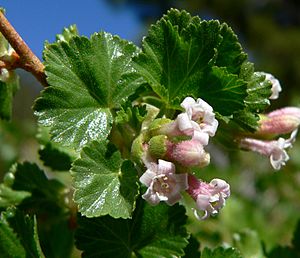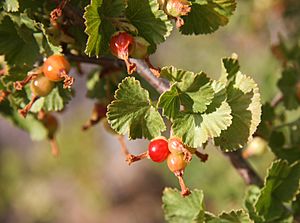Wax currant facts for kids
Quick facts for kids Wax currant |
|
|---|---|
 |
|
| Ribes cereum var. cereum, from the Spring Mountains, southern Nevada | |
| Scientific classification | |
| Genus: |
Ribes
|
| Species: |
cereum
|
| Varieties | |
|
Ribes cereum var. colubrinum C.L.Hitchc. |
|
The wax currant (scientific name: Ribes cereum) is a type of currant plant. One special kind, R. c. var. pedicellare, is even called the whisky currant. This plant grows naturally in western North America. You can find it in places like British Columbia and Alberta in Canada. It also grows across much of the western United States. This includes states like Washington, Oregon, and California. Its range stretches east to the western Dakotas and the Oklahoma Panhandle.
Contents
Where Wax Currants Grow
Wax currants are tough plants. They can live in many different places. You might see them in mountain forests, even in very cold alpine climates. They also grow in dry areas with sagebrush or in woodlands.
Soil Types for Wax Currants
This plant is not picky about soil. It can grow in sandy soils or soils made of clay. It even thrives in special soils like serpentine soils. You can also find it growing on lava beds.
What Does a Wax Currant Look Like?
The wax currant is a shrub. It can spread out or grow straight up. It usually reaches a height of 20 centimeters (8 inches) to 2 meters (80 inches). The plant has a nice, "spicy" smell.
Stems and Leaves
Its stems are fuzzy and often have many tiny glands. Unlike some other currants, this plant has no sharp spines or prickles. The leaves are somewhat round. They are divided into small, shallow sections. These sections have jagged edges like tiny teeth. The leaves can be smooth or quite hairy. They usually have small, clear resin glands, especially around their edges.
Flowers and Berries
The flowers grow in a cluster called a raceme. Each cluster has 2 to 9 small flowers. The flowers are shaped like tubes. Their white to pink sepals curl open at the tips. Inside, there are tiny white or pinkish petals. Each flower also has five stamens and two green styles that stick out.
The fruit is a red berry. It can be up to a centimeter (0.4 inch) wide. These berries are often described as not having much taste. They have a long, dried flower part still attached at one end.
Uses of Wax Currant
Native American people have used wax currants for food. The Zuni people, for example, ate the berries from the pedicellare variety. They also ate the leaves mixed with uncooked mutton or deer fat.
Eating the Berries
The berries can sometimes have an unpleasant flavor. They are also described as being "somewhat toxic" if eaten in large amounts. However, when the fruits are fully ripe, they can be good to eat. People sometimes use them to make jam or fillings for pies.



